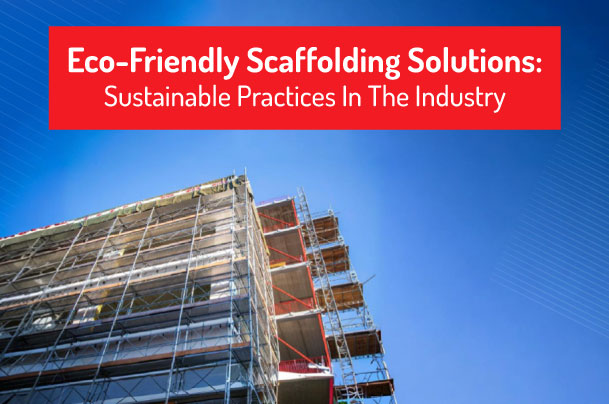
In the era of sustainable living, many construction companies are adopting eco-friendly practices. Among the most important components, scaffolds play a role in the future ahead. But, do you know about the sustainable practices prevalent in the industry? Scroll through this article to know more about sustainable practices and scaffold solutions.
Environmental Impact of Traditional Scaffolding
There are many factors that can cause the environmental impact of traditional scaffolding. These are associated with the use of the structure, and the materials. Here’s how the scaffold can affect the environment.
Use and Production
While producing scaffolding components, materials like aluminum and steel are used. These are sourced through drilling, and mining. Thus, when activities are carried out, it leads to pollution and gas emissions. During the production of wood scaffolding, deforestation can affect the environment. However, many people are working towards recycling the materials to mitigate the impact. On the other hand, when scaffolds are used, they affect the region due to energy consumption. While the site needs energy for cooling, and lighting, the production phase also uses energy.
Waste Generation
If worn-out components are not handled properly, then it can significantly affect the environment. For instance, workers have to dispose of wooden boards carefully. In case they come in contact with air, then they tend to rot. Decomposition of woon can also emit certain gasses. However, when aluminum and steel scaffolds are used, they can be recycled. Proper disposal can reduce waste and prevent the environment from ruining.
Resource depletion
As the construction project commences, people are going to extract raw materials. These include gravel and sand, used for concrete production. So, when there’s an ongoing demand for concrete, you can expect resource depletion. Additionally, there would be soil erosion and habitat destruction. In fact, the region would surely get ruined. This is because it will not appear as it was in the past.
Ultimately, just imagine that the project is progressing near an inhabited area. In such a case, erecting a scaffold can disturb the local ecosystem. Flora and fauna may also get affected due to the construction activities. So, it’s vital to think about sustainable scaffold solutions.
Temporary vs. Permanent Scaffolding: What’s the Difference?
While workers need a stable structure, they may opt for permanent or temporary scaffolds. As the name implies, temporary scaffolding is a structure that’s erected for a short period. These are often designed in a way that workers can assemble or dismantle them with ease. The scaffolds also offer flexibility to conduct tasks like setting up window panes, or painting walls. But, a permanent scaffold is used for a long time, and it’s integrated into a structure. These are useful when workers have to access areas for inspections and maintenance. Even though it can involve a high investment, people always prefer these. They no longer have to spend time in repetitive scaffold setups. Nevertheless, choosing among scaffolding systems will depend on the project’s duration, requirements, and budget.
Key Features of Sustainable Scaffold Solutions
There are various features of sustainable scaffold solutions. These help in minimizing environmental impact while maintaining safety. Let’s check these out in detail.
Recycled Materials
Utilization of recycled material is surely a great way to move ahead with sustainability. Manufacturers may first prefer using materials like steel and aluminum. But, with recycled materials, companies can design eco-friendly scaffolds. These reduce carbon emissions and conserve naturally existing resources. This trend is prevalent in manufacturing of green scaffolding systems.
Modular Design
When builders consider a modular scaffold, it boosts efficiency and reduces material waste. These systems have components that can be interchanged. Workers can also reuse the scaffold with different configurations. Once the construction process is streamlined, they will reduce environmental impact. This, in turn, saves considerable time and resources.
Biodegradable Components
Use of biodegradable parts is yet another feature of sustainable scaffolding solutions. These are certainly a better alternative to usual materials. For instance, some companies may produce straps, and nets using plastic among the scaffolding materials. Once these are used often, they will decompose without affecting anything. So, such parts reduce the effect on the environment even when they are not in use.
Energy-Efficient Manufacturing
With energy-efficient production phases, companies are now able to reduce the carbon footprint. By using wind or solar energy, factories are also able to alter the manufacturing techniques. This considerably reduces emissions as well as waste formation. The current sustainable practices are also protecting and conserving the outdoor atmosphere.
Lifecycle assessment programs
As companies strive to focus on sustainability, lifecycle evaluation programs are thought of. Such a feature of sustainable scaffold solutions is executed with an aim to assess the impact of scaffold systems. Organizations are running such programs right from the start of production. Primarily, they are analyzing different phases like material sourcing, and disposal along with the prime production phase. After comprehending the phases, they can now reduce waste and preserve resources.
Conclusion
Finally, sustainable scaffold solutions promise you a road to construction practices, friendly to the environment. Companies can make a difference by using modular designs, and pacing ahead with energy-efficient manufacturing processes. As people refine their focus on sustainability, eco-friendly scaffold solutions will transform the future.
Still seeking the most reliable scaffold equipment supplier? Choose Scaffolds Supply, which has always maintained quality and catered to diverse industries. Once you glimpse through our online store, you can check out a range of scaffolding components.











Comments are closed